Creating an inclusive classroom environment is crucial to fostering a positive learning experience for all students. Here are some starter strategies to help you on the road to a more inclusive classroom.

Cultivating an Inclusive Classroom
One of our fundamental responsibilities as teachers is to create a place where every student feels welcome and supported, no matter where they come from or what they’re good at. Here, we discuss what makes a teacher and a classroom inclusive and offer advice on the best ways to work toward inclusivity.
Inclusive Teachers – What’s Their Secret?
An inclusive teacher appreciates that getting to know each student as a unique person is the key to a welcoming classroom. Such teachers take the time to learn who their students are, what their students like, what they’re good at, and what challenges they might face inside and outside of the classroom. This process lays the foundation for students to have a respectful, sensitive educational experience.

How We Can Promote Inclusivity in the Classroom

It is not enough to know which students have an IEP. Inclusivity means knowing and understanding the barriers to learning that students may face. For example:
- Speaking English as a second language or not having English speakers at home.
- Living below the poverty level, receiving free school meals, or struggling with homelessness.
- Facing prejudices, both conscious and unconscious, due to their ethnicity, nationality, religion, country of origin, gender, physical abilities or other perceived differences.
- Institutional racism – where the fundamental basis of some social systems and is structured to reinforce inequality.
- Cultural backgrounds or experiences that leave a child reluctant or unable to participate freely in classroom activity. This can be through both simple misunderstandings about what and what is not allowed, or it may be an overt barrier such as being unable to eat specific snacks or handle particular objects.
- Having an unstable or unsupportive family dynamic.
- Living in a home in which there are drugs, alcohol, or other forms of abuse, violence, or criminal behavior.
- Bullying or other forms of social isolation.
Clear Rules & Expectations

Click here for the FREE Classroom Expectations & Listening Rules download.
Once we understand student needs, we can make some clear rules for our classrooms. These rules are about more than just keeping things organized and running smoothly. The rules in an inclusive classroom also ensure every student, teacher, helper, and visitor understands the expectations of kindness, respect, and acceptance toward themselves and each other.
Every student should understand that inclusivity and respect cover every aspect of their educational experience, including:
- How they speak with and behave toward each other both inside and outside the classroom.
- Any items they bring into the classroom from outside the school.
- The content of assignments, projects, and other school work.
- How they represent school while on trips, excursions, or taking part in school-led extra-curricular activities.
Once these rules are in place and understood, be sure to enforce them consistently.
A Welcoming Physical Environment
Click here for the FREE Kindness Kit
A physical environment that makes our students feel wanted, included, and seen is essential. There are many ways in which you can make your classroom and the rest of the school, if possible, more inclusive.
Decor
- Ensure your displays, artwork, posters, etc., include multicultural and inclusive elements. Look around your classroom and ask yourself if the surroundings you create reflect the students you support.
- Hang a variety of charts, learning prompts, and other materials that your students can identify with. This helps to encourage engagement from everyone.
- Encourage students to bring photographs of their families and loved ones to create a display celebrating the diverse nature of family structures.
- Use low-tac tape or colored carpets or rugs to distinguish the different areas of your classroom. This provides a visual cue for where your students should or should not be at any given time.
Where you can, expand this colored/themed look to the walls for specific learning areas or centers. - For students who struggle with visual clutter, especially those with some form of ASD, ADHD or sensory issues, single blocks of bright color on bulletin boards or displays make better backgrounds than busier patterns or pictures.
- Ensure you regularly alternate displays of student work. Every student should have the opportunity to see their work displayed and celebrated.
- Create hand signal displays so all students can learn some non-verbal communication. This doesn’t only benefit children with special educational needs or specific speech and language pathologies; it also helps children who may have English as a second language or those who struggle to speak up.
Furniture & Lay-Out

- Arrange the furniture in your classroom so that it is easy for everyone to navigate.
- Instead of storing supplies in one area, consider several small, mobile supply options. This not only prevents all of your students from trying to get to one spot at a time, but it also gives shy or more introverted students relief from the rush and crush and prevents them from always being one of the last to get what they need.
- Provide multiple seating options, for example, a standing desk, floor cushions, wobble stools, bean bags, etc.
- Designate a quiet area or corner where students can go if they feel overwhelmed.
Teaching Methods & Materials
Click here for the FREE all levels Made For Me Literacy: How to Be a Friend
Many inclusive teaching methods and materials benefit everyone in the classroom, not just those for whom an accommodation is essential.
- Create or source visual timetables, routine cards, etc., that feature a diverse collection of children.
- Provide toys, books, and other resources that reflect your students. Ensure everyone in your classroom can see themselves, their family, or their experiences reflected in their learning resources.
- Teach and provide materials about a wide variety of national, cultural, religious, and social celebrations, i.e. Eid, Yom Kippur, Diwali, Pride, and Chinese New Year. Add these dates to your classroom calendar.
- Wherever possible, have family members volunteer or participate in your class.
- Encourage activities and events that allow children and their adults to share their backgrounds and experiences.
- Consider your use of language; for example – when speaking with your children, you can reference the adults they live with instead of automatically referring to mom and dad.
- Incorporate tactile items, visual aids, non-slip mats, and other materials that support a range of learning styles and needs.
- If you print items yourself, ensure the fonts are clear and easy for everyone to read.
- As long as they do not create distractions, allow the use of fidgets, headphones, and even emotional support items.
- Present material in multiple formats to accommodate different learning styles or needs.
- Consider teaching everyone (if practical) how to use assistive technologies. This can expand the range of people with whom students can comfortably interact.
- Provide various engagement options so that kids who work well alone can flourish in the same way as children who work best in a group.
- Continue your own education about inclusivity and diversity. Attend workshops and conferences, and seek resources to enhance your inclusive teaching practices.
This is by no means a comprehensive list of ways to create an inclusive classroom. Inclusivity and respect are an ongoing journey for us all, and there is always more we can do.
However, adopting some of the strategies we’ve shared here will help you along the road to a more inclusive classroom.



Leave a Reply